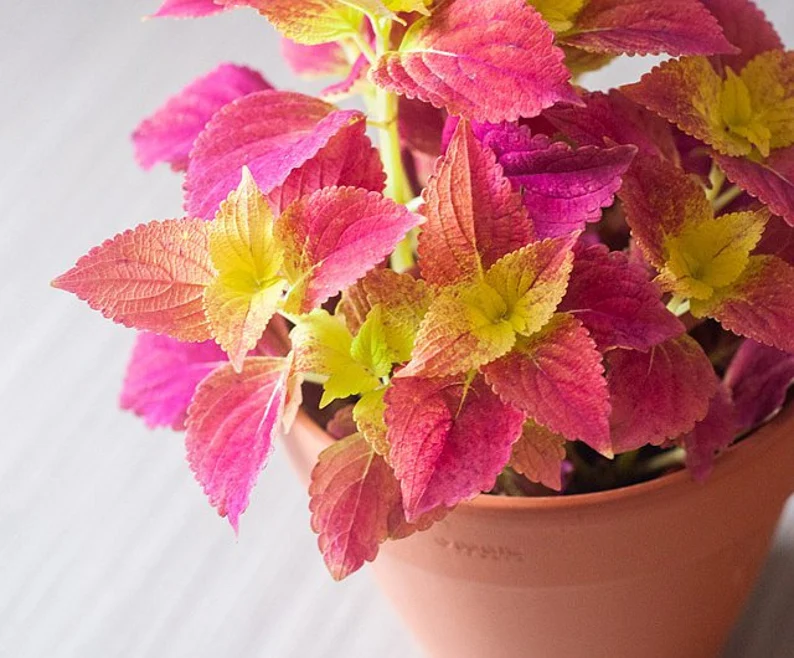Looking to Purchase Alabama Sunset Coleus?
Try checking out our shop page or our Esty shop at MyGardenchannelCOM

Alabama Sunset Coleus (Solenostemon scutellarioides ‘Alabama Sunset’) is a vibrant and eye-catching foliage plant known for its dynamic color-changing leaves. Its hues range from bright pink and gold in full sun to deep burgundy and red in shaded areas, making it a versatile addition to gardens and container arrangements. This guide covers all aspects of caring for Alabama Sunset Coleus, ensuring it thrives in your garden or indoor space.
1. Understanding Alabama Sunset Coleus
Alabama Sunset is a cultivar of Coleus, prized for its strikingly colored leaves and easy maintenance. It is a tender perennial in warm climates (USDA Zones 10-11) but is commonly grown as an annual in cooler regions. This variety can grow up to 24 inches tall and spread 18-24 inches wide, forming a bushy, lush display.
Growth Characteristics
- Height: 18-24 inches
- Width: 18-24 inches
- Foliage Color: Pink, gold, red, burgundy (varies with light exposure)
- Flowering: Insignificant lavender to blue spikes
- Lifespan: Perennial in warm climates, annual in colder regions
2. Light Requirements
One of the most distinctive features of Alabama Sunset Coleus is its ability to change leaf color based on light exposure.
Full Sun vs. Shade
- Full Sun (6+ hours/day): Leaves develop intense pink and golden tones.
- Partial Shade (3-6 hours/day): Foliage transitions to a mix of reds and burgundies.
- Full Shade (Less than 3 hours/day): Richer burgundy and deeper red hues dominate.
For optimal color vibrancy, provide morning sun with afternoon shade, especially in hot climates where full midday sun may scorch the leaves.
3. Soil and Planting Requirements
Proper soil preparation is crucial for the healthy growth of Alabama Sunset Coleus.
Soil Preferences
- Type: Well-draining, loose soil
- pH Range: Slightly acidic to neutral (6.0-7.0)
- Amendments: Add compost or organic matter to improve soil structure and fertility.
Planting Guidelines
- Space plants 12-18 inches apart to allow for air circulation.
- Plant in spring after the last frost if growing outdoors.
- For containers, use high-quality potting soil and ensure proper drainage.
4. Watering and Humidity Needs
Alabama Sunset Coleus requires consistent moisture but should not sit in soggy soil.
Watering Schedule
- Outdoor Plants: Water deeply 2-3 times per week during dry spells.
- Container Plants: Check daily; water when the top inch of soil feels dry.
- Indoor Plants: Water every 5-7 days, adjusting based on humidity levels.
Humidity Considerations
- Prefers moderate to high humidity (50% or more).
- If grown indoors, mist occasionally or place a humidity tray nearby.
5. Fertilization and Feeding
Regular feeding encourages lush growth and vibrant colors.
Fertilizer Type
- Use a balanced, water-soluble fertilizer (10-10-10 or 20-20-20) every 2-4 weeks during the growing season.
- Organic options like compost tea or fish emulsion can be used for sustainable growth.
Seasonal Feeding Schedule
- Spring-Summer: Fertilize every 2-4 weeks.
- Fall-Winter: Reduce feeding if plant growth slows indoors.
6. Pruning and Maintenance
Regular pruning keeps the plant compact and encourages bushier growth.
Pruning Tips
- Pinch back growing tips every few weeks to prevent legginess.
- Remove flower spikes as they appear to redirect energy to foliage production.
- Trim any damaged or overly long stems to maintain shape.
7. Propagation Methods
Coleus is easy to propagate through stem cuttings, making it an excellent choice for gardeners who want to expand their collection.
Steps for Propagation
- Take a 4-6 inch cutting from a healthy stem just below a node.
- Remove the lower leaves and place the cutting in water or moist soil.
- Keep in a warm, bright location out of direct sunlight.
- Roots should develop within 1-2 weeks, after which the cutting can be transplanted.
8. Pest and Disease Management
Although relatively pest-resistant, Alabama Sunset Coleus can sometimes attract common garden pests.
Common Pests
- Aphids: Cause curling leaves; treat with insecticidal soap.
- Spider Mites: Create webbing and cause yellowing; control with neem oil.
- Whiteflies: Can weaken plants; use sticky traps or insecticidal soap.
Common Diseases
- Powdery Mildew: Appears as white powdery spots; improve air circulation and use a fungicide if necessary.
- Root Rot: Caused by overwatering; ensure proper drainage and avoid excessive moisture.
9. Overwintering Alabama Sunset Coleus
In colder climates, Coleus must be protected from frost to survive the winter.
Bringing Plants Indoors
- Before the first frost, dig up outdoor plants and transplant them into pots.
- Place in a bright, warm location indoors.
- Reduce watering slightly during the winter months.
Taking Cuttings for Winter Storage
- If space is limited, take stem cuttings and root them indoors.
- Store in a warm spot and transplant back outside in spring.
10. Uses in Landscaping and Design
Alabama Sunset Coleus is highly versatile and can be used in various garden designs.
Garden Applications
- Borders & Edging: Creates vibrant color contrast along pathways.
- Containers & Hanging Baskets: Perfect for patio displays and small spaces.
- Companion Planting: Pairs well with ferns, begonias, and impatiens.
- Mass Planting: Creates a striking visual impact in garden beds.
Watermelon Peperomia (Peperomia argyreia) Care Guide
Introduction Watermelon Peperomia (Peperomia argyreia) is a delightful houseplant beloved for its unique, showy foliage. Named for its striking leaves that resemble watermelon rinds—oval-shaped with silver and dark green stripes—thisRead More
Waikiki Elephant Ear (Colocasia ‘Waikiki’) Care Guide
Introduction The Waikiki Elephant Ear is a showstopping tropical plant prized for its striking foliage. A cultivar of Colocasia esculenta, ‘Waikiki’ stands out with large, heart-shaped leaves in deep green,Read More
Violet Primrose (Primula spp.) Care Guide
Introduction to Violet Primrose The violet primrose is a delightful early-blooming perennial belonging to the Primula genus, which includes over 500 species. Known for their cheerful blossoms and delicate foliage,Read More
Violet Hollyhock Care Guide
Introduction to Violet Hollyhock (Alcea rosea) Violet Hollyhock, scientifically known as Alcea rosea, is a striking perennial flower that is beloved by gardeners for its tall, stately stems and large,Read More
Vinca ‘Wojo’s Gem’ Care Guide
Vinca ‘Wojo’s Gem,’ also known as Periwinkle or Madagascar Periwinkle, is a popular ornamental plant admired for its attractive, glossy foliage and vibrant flowers. It is a hybrid variety ofRead More
Care Guide for Variegated White Lighting Crown of Thorns (Euphorbia milii)
The Variegated White Lighting Crown of Thorns (Euphorbia milii), also known as the Crown of Thorns plant, is a stunning, hardy succulent that produces vibrant flowers and can thrive inRead More

